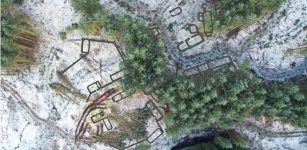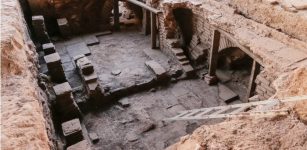Excavations Of 2,500-Year-Old Water Cistern In Croatian Village Lumbarda – Completed
Conny Waters - AncientPages.com - Researchers have completed the excavation of a huge 2,500-year-old water cistern, located in Lumbarda on the southern Croatian island of Korčula.
Throughout its history, Lumbarda was a region combining various nations and cultures, and current research revealed that the first inhabitants were the Illyrians, ruling the island during the Bronze and Iron Age.
 Ancient water cistern in Lumbarda on Korčula island. Image Photo credit: Dora Lozica
Ancient water cistern in Lumbarda on Korčula island. Image Photo credit: Dora Lozica
They left a number of artifacts unearthed by archaeologists in the graves and strategic stone stacks, located on the western areas of Lumbarda.
The ancient water cistern also happens to be the place where the legendary Psephisma - the Oldest Document about the division of land parcels in Croatia from the beginning of the 4th or 3rd Century BC - was found, one of the most important monuments of Hellenism in Europe.
Lumbarda Psephisma is a stone inscription telling about the founding of an ancient Greek settlement on the island of Korčula. The Psephisma was discovered in the ruins of the cistern on Koludrt hill in 1877 by Božo Kršinić. The inscription is considered as one of the oldest written monuments in Croatia. At the same time, it is a monument about the distribution of land to the Greek colonists in Croatia.
The artifact is a red-brownish lime-stone surmounted by a triangular decorative panel, about 1 meter high and 13 cm thick, with inscriptions 69 cm wide.
 Lumbarda Psephisma. Image: HINA/ Lana Slivar Dominic
Lumbarda Psephisma. Image: HINA/ Lana Slivar Dominic
The stone inscription has a written decree that details the agreement surrounding the establishment of a Greek colony in the 4th or 3rd century BC. It is proof of the first urban center established in Lumbarda on the island of Korčula. Moreover, this ancient stone document is widely used by Croatian and foreign authors for studying Greek colonization.
With the intrusion of Greek interests on the Adriatic, the island became known as Korkyra Melaina (black), and as such, the region was of great importance to the Greeks, establishing two settlements on the Black Korkiri. The latter settlement was founded in the 3rd century in Lumbarda.
The most renowned and significant Antic stone inscription found in the Republic of Croatia gives witness to this historical event.

Lumbarda Psephisma. Image credit: Archaeological Museum in Zagreb
The recent archaeological discovery of 2,500-year-old water cistern dates from the same period as the Lumbarda Psephisma, the end of the 4th and the beginning of the 3rd century BC.
According to conservator Krešimir Bosnić, “especially the plaster, which is exceptional and unusual in every respect, is technically very well executed. However, since it, as in any other archeological site, is located outside – it is exposed to various conditions of decay.”
Cisterns were often built to catch and store rainwater and are distinguished from wells by their waterproof linings.
“The tank is huge, 10×17 meters in floor plan size and preserved height in the deepest part of 3 and a half meters. That’s a huge amount of water. Technologically, it is a fascinating object that is unique in the Mediterranean,” said archaeologist Hrvoje Potrebica.
One of the puzzles is that it is open, has no traces of a roof structure, but monumental in its size – there is no Hellenistic building on the east coast of the Adriatic that could match it. That is why the cistern is big news in the world of archeology, and it was recorded with the most modern 3D scanner in the world.
“We currently have the most modern scanner in the world that recorded a tank with 430 million points. So our resolution is one millimeter, so we hope that we will get documentation and an exceptional means of monitoring,” explains Potrebica.
Written by Conny Waters - AncientPages.com Staff Writer
More From Ancient Pages
-
 2,000-Year-Old Medusa Mosaic Is Considered The Pearl Of Ancient City Of Kibyra
Archaeology | Aug 25, 2020
2,000-Year-Old Medusa Mosaic Is Considered The Pearl Of Ancient City Of Kibyra
Archaeology | Aug 25, 2020 -
 Medieval Mythbusting – Rewriting of History Of Glastonbury Abbey
Archaeology | Nov 23, 2015
Medieval Mythbusting – Rewriting of History Of Glastonbury Abbey
Archaeology | Nov 23, 2015 -
 Abydos: One Of The Most Important Cities Of Ancient Egypt
Featured Stories | Jul 15, 2016
Abydos: One Of The Most Important Cities Of Ancient Egypt
Featured Stories | Jul 15, 2016 -
 The Hidden History of China’s Secret Societies
Featured Stories | Nov 23, 2014
The Hidden History of China’s Secret Societies
Featured Stories | Nov 23, 2014 -
 Ancient DNA Reveals The Earliest Evidence Of The Last Massive Human Migration To Western Europe
DNA | Jul 24, 2023
Ancient DNA Reveals The Earliest Evidence Of The Last Massive Human Migration To Western Europe
DNA | Jul 24, 2023 -
 Vikings’ Unicorn Bluff Fooled Europeans For Hundreds Of Years
Ancient History Facts | Apr 24, 2018
Vikings’ Unicorn Bluff Fooled Europeans For Hundreds Of Years
Ancient History Facts | Apr 24, 2018 -
 Huge Phitos (Jar) Unearthed In Ancient City Of Prusias ad Hypium, Turkey
Archaeology | Jun 26, 2022
Huge Phitos (Jar) Unearthed In Ancient City Of Prusias ad Hypium, Turkey
Archaeology | Jun 26, 2022 -
 The 5th Century BC Gela II Wreck Linked To Orichalco Cargo Salvaged In Sicily
Archaeology | Oct 8, 2024
The 5th Century BC Gela II Wreck Linked To Orichalco Cargo Salvaged In Sicily
Archaeology | Oct 8, 2024 -
 Ancient DNA Sheds Light On ‘Lost’ Indigenous People Of Uruguay And Reveals A Surprising Connection
Archaeology | May 11, 2022
Ancient DNA Sheds Light On ‘Lost’ Indigenous People Of Uruguay And Reveals A Surprising Connection
Archaeology | May 11, 2022 -
 Ruins Of Post-Medieval Brunell Township Discovered In Glen Brittle Forest On The Isle of Skye
Archaeology | Feb 29, 2024
Ruins Of Post-Medieval Brunell Township Discovered In Glen Brittle Forest On The Isle of Skye
Archaeology | Feb 29, 2024 -
 Amazing Victorian Time Capsule – 135-Year-Old Message In A Bottle Found In Edinburgh
Archaeology | Nov 22, 2022
Amazing Victorian Time Capsule – 135-Year-Old Message In A Bottle Found In Edinburgh
Archaeology | Nov 22, 2022 -
 10 Ancient Love Symbols
Ancient Symbols | Jan 5, 2016
10 Ancient Love Symbols
Ancient Symbols | Jan 5, 2016 -
 Was Biblical King David Unknowingly Part Of A Secret Master Plan?
Ancient Mysteries | Jul 1, 2021
Was Biblical King David Unknowingly Part Of A Secret Master Plan?
Ancient Mysteries | Jul 1, 2021 -
 ‘Exceptional’ Ancient Roman Bath Complex Discovered In Mérida, Spain
Archaeology | Aug 21, 2023
‘Exceptional’ Ancient Roman Bath Complex Discovered In Mérida, Spain
Archaeology | Aug 21, 2023 -
 Ancient Human Remains A The Sima De Los Huesos Site Investigated
Archaeology | Mar 15, 2023
Ancient Human Remains A The Sima De Los Huesos Site Investigated
Archaeology | Mar 15, 2023 -
 Massive Underground Anomaly – Iron Ages Temples And Seat Of Legendary Ulster Kings Discovered At Navan Fort?
Archaeology | Jul 21, 2020
Massive Underground Anomaly – Iron Ages Temples And Seat Of Legendary Ulster Kings Discovered At Navan Fort?
Archaeology | Jul 21, 2020 -
 Great Lady Of Champagne – Barbe-Nicole Clicquot Ponsardin: Widow, Mother, Skilled Businesswoman
Featured Stories | Aug 22, 2019
Great Lady Of Champagne – Barbe-Nicole Clicquot Ponsardin: Widow, Mother, Skilled Businesswoman
Featured Stories | Aug 22, 2019 -
 On This Day In History: Terracotta Army Buried With Emperor Qin Shi Huang Discovered – On Mar 29, 1974
News | Mar 29, 2017
On This Day In History: Terracotta Army Buried With Emperor Qin Shi Huang Discovered – On Mar 29, 1974
News | Mar 29, 2017 -
 Mysterious Mongolian Arc Investigated By Scientists
Archaeology | Jan 2, 2024
Mysterious Mongolian Arc Investigated By Scientists
Archaeology | Jan 2, 2024 -
 World’s Oldest Bread Found In Neolithic Oven In Çatalhöyük, Turkey
Archaeology | Mar 12, 2024
World’s Oldest Bread Found In Neolithic Oven In Çatalhöyük, Turkey
Archaeology | Mar 12, 2024
